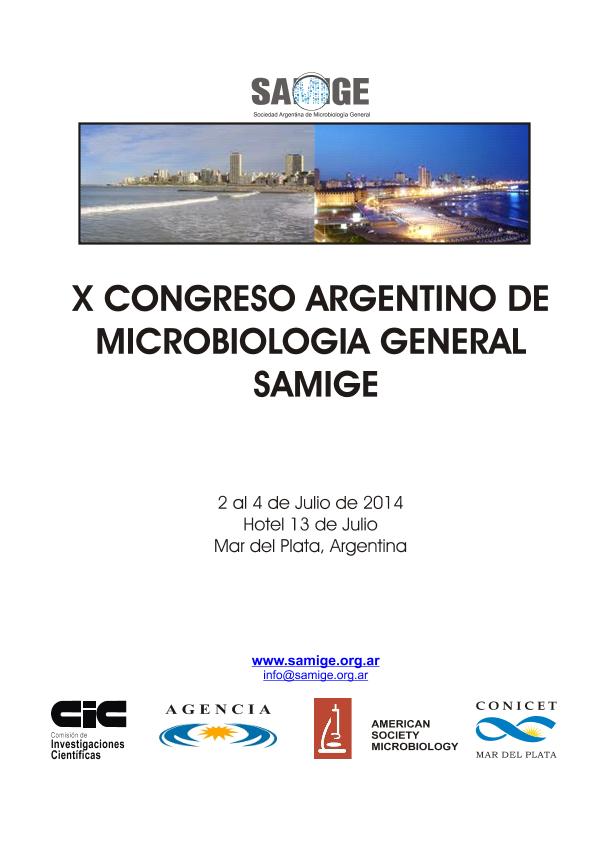Evento
Levaduras endofiticas de caña de azucar presentan actividad quorum quenching
Título:
Endophytic yeast from sugarcane exhibit quorum quenching activity
Tipo del evento:
Congreso
Nombre del evento:
X Congreso Argentino de Microbiología General
Fecha del evento:
02/07/2014
Institución Organizadora:
Sociedad Argentina de Microbiología General;
Título del Libro:
Libro de Resúmenes: X Congreso Argentino de Microbiología General
Editorial:
Sociedad Argentina de Microbiología General
Idioma:
Inglés
Clasificación temática:
Resumen
Quorum sensing (QS) are signaling mechanisms that govern morphological and physiological responses to changes in cell density. QS enables microorganisms to communicate via secreted signaling molecules called autoinducers. Many of these autoninducers bellong to a N-acyl homoserine lactones`s (AHLs) family. AHLs are synthesized by Gram negative bacterias and their structure consist of a carbon N-acyl side chain linked to a lactone ring. These molecules are pH-dependent so the lactone ring will be reversibly hydrolyzed. On the other hand, Quorum quenching (QQ) is a process which disrupts the QS by different ways such as enzymatic lysis of the signal molecules. QQ allows to control many physiological mechanisms from pathogen gram negative bacteria. In view of this, the aim of the present work was to isolate yeasts with QQ properties from Saccharum officinarum, a species of sugar cane. Samples from roots, stems and leaves were plated onto YM agar. Incubation was carried out at 30ºC. Colonies with different morphotypes were selected and plated. Pure colony was obtained by repeated streaking on YM agar. The genomic DNA of the yeast isolates were extracted to identify them. They were used as template for PCR. The 26S rDNA gene was PCR-amplified using the following primers namely NL1 and NL4. Nucleotide sequences were compared with GenBank databases using the BLASTN program followed by sequence alignment Yeasts were incubated onto YM supplemented with HSLs comercial standards (C6-HSL, 3-oxo-C6-HSL, C10-HSL, 3-oxo-C10-HSL, C12-HSL, 3-oxo-C12-HSL, C8-HSL and 3-oxo-C8-HSL) to demostrate the presence of QQ mechanisms. After 2 days incubation supernadants of cultures were taken and the detection of HSLs degradation was carry out using two biosensor strains, Chromobacterium violaceum CV026 and Chromobacterium violaceum Vir07. If necessary acidification for re-lactonisation using HCl was performed. 19 yeast strains were finally isolated. Sequencing of 26S rDNA indicated that 19 strains bellonged to three different genus (Pichia, Rhodotorula and Sporisorium). In the QQ assay, all yeasts tested were able to degradate at least one of the proven HSLs comercial standards. The isolates presented a marked tendecy to hidrolyse long-acyl-chain compounds. However, two Rhodotorula strains exhibited the most outstanding behavior, by degradating the 8 different QS molecules assayed. In order to demostrate lactonase activity, supernadants of cultures were adicionated with HCl. The following bioassays revealed that at low pH levels the lactone rings were closed again suggesting the presence of lactonase enzymes in Rhodotorula yeasts.
Palabras clave:
YEAST
,
QUORUM QUENCHING
,
ENDOPHYTIC
,
SUGARCANE
Archivos asociados
Licencia
Identificadores
Colecciones
Eventos(PROIMI)
Eventos de PLANTA PILOTO DE PROC.IND.MICROBIOLOGICOS (I)
Eventos de PLANTA PILOTO DE PROC.IND.MICROBIOLOGICOS (I)
Citación
Levaduras endofiticas de caña de azucar presentan actividad quorum quenching; X Congreso Argentino de Microbiología General; Mar del Plata; Argentina; 2014; 1-2
Compartir




